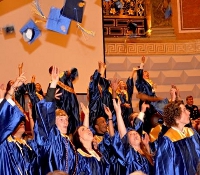
In 1492, Columbus sailed the ocean blue on a flagship built to weather storms. Today's navigators can tap naval and marine engineers to design fuel-efficient propulsion systems or huge cargo vessels that barely squeak through the Panama Canal. This week's activity will expand your explorers' engineering horizons. See if it float their boats! And for a totally different adventure, read our story on the structural engineers rappelling down the Washington Monument. For Navy-related student research opportunities, check out the Science and Engineering Apprenticeship Program (SEAP) and the Naval Research Enterprise Intern Program (NREIP). Download our Teacher Guide for more ideas! |
| Lesson: Made to Sail
 In this lesson, students in grades 2 - 7 use simple materials to design and make model sailboats that must stay upright and sail straight in a testing tank. They will learn the basic components of a ship and how design represents a tradeoff between speed, stability, and ease of handling. In this lesson, students in grades 2 - 7 use simple materials to design and make model sailboats that must stay upright and sail straight in a testing tank. They will learn the basic components of a ship and how design represents a tradeoff between speed, stability, and ease of handling.
Read More
|
|
Feature: The Life of Naval Architects
 Engineers are responsible for building planes, trains, and automobiles, but what about those who are more aquatically inclined? Budding Captain Nemos may want to consider pursuing Naval Architecture and Marine Engineering, a field of study dedicated to the design, construction, and maintenance of ships. Engineers are responsible for building planes, trains, and automobiles, but what about those who are more aquatically inclined? Budding Captain Nemos may want to consider pursuing Naval Architecture and Marine Engineering, a field of study dedicated to the design, construction, and maintenance of ships.
Read More
Many Leagues Under the Sea
|
| K-12 News: More Start, Fewer Finish College
 Despite decades of steadily climbing college enrollment rates, the percentage of students earning a degree or certificate on time has barely budged, a new study reveals. By including older and part-time students, the Complete College America report paints a more comprehensive picture of the gap between college aspirations and outcomes than federal data typically has captured. Despite decades of steadily climbing college enrollment rates, the percentage of students earning a degree or certificate on time has barely budged, a new study reveals. By including older and part-time students, the Complete College America report paints a more comprehensive picture of the gap between college aspirations and outcomes than federal data typically has captured.
Read More
|
| Special: ASEE Partners with NSTA
 The American Society for Engineering Education (ASEE) has put together a public/private partnership to develop ways of engaging elementary, middle, and high school students in engineering. Participants will learn about innovative, hands-on, project-based engineering at three events during National Science Teachers Association regional conferences. The American Society for Engineering Education (ASEE) has put together a public/private partnership to develop ways of engaging elementary, middle, and high school students in engineering. Participants will learn about innovative, hands-on, project-based engineering at three events during National Science Teachers Association regional conferences.
Read More
|
|
|